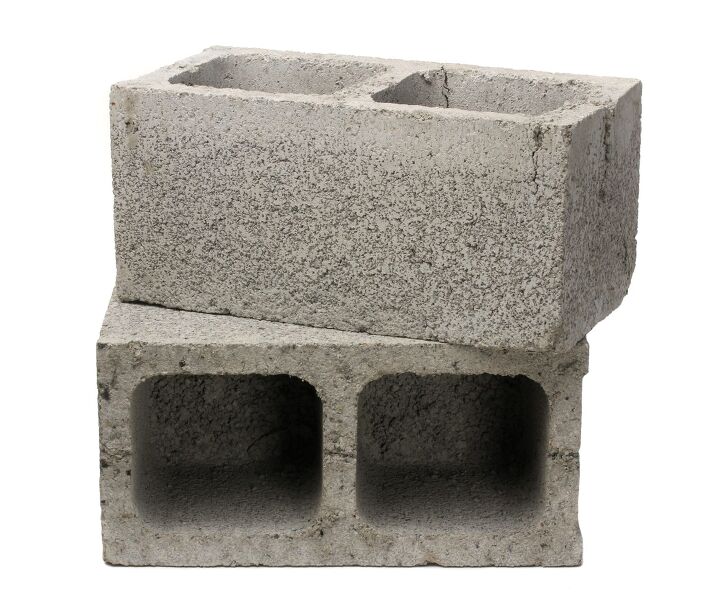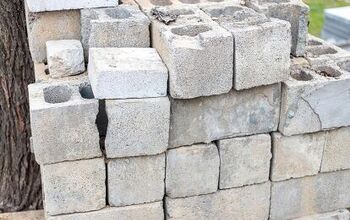How Much Does A Cinder Block Weigh?

Cinder blocks come in handy for all sorts of home projects, from building walls to making DIY furniture creations. These concrete masonry units (CMUs) come in many sizes, providing versatility to work in various applications, but they can get heavy. Before you start lugging them around, know how much cinder blocks weigh so you can plan your tasks accordingly.
Cinder blocks weigh between 15 and 56 pounds. The most common size is a hollow block (with two holes) 8 inches by 8 inches by 16 inches and weighs 38 pounds. Single hollow blocks with one hole are 8 x 8 x 8 inches and weigh 18 pounds. Solid blocks weigh significantly more than hollow blocks.
As you start planning your specific project and making your supply list, take note of different cinder block weights. Certain jobs might have particular weight limits, or you may have restrictions on how much you can lift. Having a general idea of what different cinder blocks weigh can help you make suitable choices.
How Much Does A 2-Hole Cinder Block Weigh?
Cinder blocks are made of concrete that features a mix of aggregate and cement. Some common ingredients in the aggregate can be debris, ash, and coal cinders, hence the name.
Since it isn’t solid cement, it’s a more lightweight block, but don’t let that fool you. Cinder blocks are still heavy.
Some of the most common styles of cinder blocks are the two-hole hollow blocks. When you hear the word cinder block, this is the type that’s most likely to come to mind.
Two-hole cinder blocks come in different sizes and weights. However, the standard block is 8 by 8 by 16 inches and weighs approximately 37 to 38 pounds. Most full-size blocks are 8 inches tall and 16 inches long. But you’ll find the width can vary.
Therefore, when someone refers to a 4-inch cinder block or a 10-inch block, etc., they are referring to the cinder block’s width. The height and length are always 8 inches and 16 inches, respectively.
Different Weights Of Standard Cinder Blocks
Two-hole blocks have the following weights. (Typically, the sizes represent width x height x length.)
| Two-Hole Cinder Block Size | Weight |
| 4” x 8” x 16” | 24 pounds |
| 6” x 8” x 16” | 25 pounds |
| 8” x 8” x 16” | 38 pounds |
| 10” x 8” x 16” | 43 pounds |
| 12” x 8” x 16” | 52 pounds |
There is also a 60% solid standard block that measures 8” x 8” x 16”, but has slightly smaller holes. These particular blocks weigh more than the traditional standard block. The smaller holes add roughly 10 pounds, making the 60% solid block weigh roughly 47 pounds.
Another interesting point is these weights are dry weights. However, cinder blocks are porous, and when they get wet, they can soak up roughly one pound of water. Therefore, if you’re dealing with wet cinder blocks, you can add one pound to each of the above weights.
How Much Do Three-Hole Cinder Blocks Weigh?
Although not as common as a two-hole block, some standard cinder blocks feature three holes. An 8” x 8” x 16” three-hole block weighs roughly 35 pounds. So it’s only a few pounds less than its two-hole counterpart.
How Much Do Single Hole Cinder Blocks Weigh?
A single hole cinder block, or half block, weighs approximately 18 to 19 pounds. It measures 8 inches by 8 inches by 8 inches.
Concrete Blocks vs Cinder Blocks
Cinder blocks and concrete blocks are not precisely the same things, even though many use the terms interchangeably. Concrete blocks weigh more than cinder blocks. The weight difference stems from their different composition.
The concrete in a concrete block is mainly cement with some sand and gravel. Since the aggregate in a concrete block is mostly gravel, it’s going to be heavier than the aggregate in cinder blocks. (Remember that cinder blocks feature an aggregate that can be a mix of ash, coal dust, etc.)
Therefore, a concrete block that is the same size as a similar style cinder block will weigh roughly 10 pounds more. Additionally, you can also find solid concrete blocks that are even heavier since there are no holes to reduce the weight.
Weights Of Solid Concrete Blocks
These solid units also come in various shapes and sizes, with several more common than others. Here are the weights and sizes of the most commonly used solid concrete blocks.
| Size of Solid Concrete Block | Weight |
| 2” x 4” x 8” | 5 pounds |
| 2” x 8” x 16” | 15 pounds |
| 4” x 8” x 16” | 33 pounds |
| 6” x 8” x 16” | 56 pounds |
| 8” x 8” x 16” | 55 pounds |
Determining The Size Of Non-Standard Cinder Blocks
There are tons of cinder blocks that go beyond the traditional rectangular or square shapes. You can find corner blocks, deck blocks, block beams, and many more. Although these various units feature different shapes, you can estimate their weight by comparing them to standard blocks.
For example, a corner hollow block that has similar measurements to a standard hollow block will weigh roughly the same. You might need to adjust up or down by one or two pounds, but it will be relatively close.
If you need to know the specific weights of each unique block, it’s best to check with the manufacturer or the store where you purchase it. These measurements are averages, but a block’s weight can vary slightly from manufacturer to manufacturer. These variances are based on exact size, density, and materials.
What’s The Best Way To Move Cinder Blocks?
A dolly or hand cart would be the best way to transport cinder blocks or concrete blocks. A two-wheel dolly provides more flexibility over the types of surfaces you can use it.
When using a dolly, you will still need to lift the blocks. However, you only need to do so one or two inches, just enough to place them on the dolly.
A four-wheel dolly or hand cart might hold more blocks at once. But it will likely only work well on flat surfaces.
What If You Don’t Have A Dolly To Move Cinder Blocks?
Another method homeowners and DIYers use is to roll the cinder blocks along on large PVC pipes. This method can work if you’re on a flat surface and have the patience to keep moving and adjusting the pipes. If you can’t invest in a dolly, then this could be a good back-up option.
You could also place a few cinder blocks on a furniture mat or blanket or towel and pull them along. Again, this method is only practical on a flat surface as it doesn’t provide a lot of control.
If you don’t have a dolly and need to move cinder blocks up or down a slope, try flipping them. It will take a lot of time, but if you’re unable to carry the block, this will get the job done. (Make sure to wear some good quality gloves to protect your hands.)
No matter what method you choose to transport cinder blocks, enlisting the help of a buddy makes it a lot easier.
How Much Weight Can Cinder Blocks Hold?
On average, concrete cinder blocks can support approximately 1,700 pounds per square inch. According to the National Concrete Masonry Association, the ASTM specifications state that every block must meet this weight requirement.
Summary
Cinder blocks come in many shapes and sizes, weighing as little as 5 pounds to over 55 pounds. However, the most common cinder block is the standard block, measuring 8” by 8” by 16” and weighing 38 pounds. The most popular sizes are 8 inches tall and 16 inches long, with widths ranging from 4 to 12 inches.
A four-inch standard block weighs 24 pounds, and a 12-inch standard block weighs 52 pounds. Porous cinder blocks can weigh up to one pound more when fully soaked with water. A 60% solid standard block weighs 47 pounds, thanks to the smaller holes.
Additionally, you can get solid concrete blocks that weigh significantly more than hollow blocks the same size. For example, an 8” x 8” x 16” solid block weighs 55 pounds. Therefore, if you’re working with odd-shaped blocks, you can estimate the weight by comparing it to a similarly sized square or rectangular block.
No matter what size cinder block you need, understanding what they weigh can help you plan well for your project, Whether you’re putting up a retaining wall, building a cool cinder block couch, or making a DIY fire pit.
Related Guides:

Stacy Randall is a wife, mother, and freelance writer from NOLA that has always had a love for DIY projects, home organization, and making spaces beautiful. Together with her husband, she has been spending the last several years lovingly renovating her grandparent's former home, making it their own and learning a lot about life along the way.
More by Stacy Randall



























